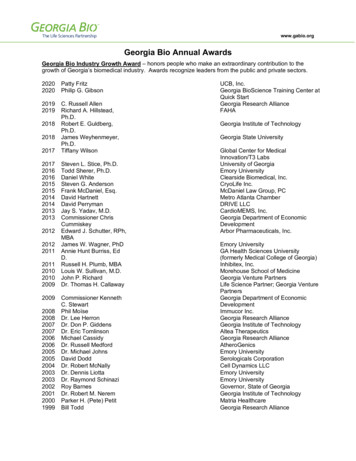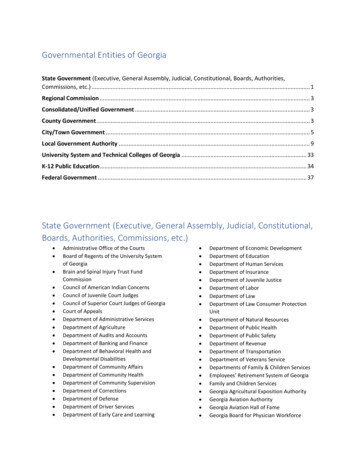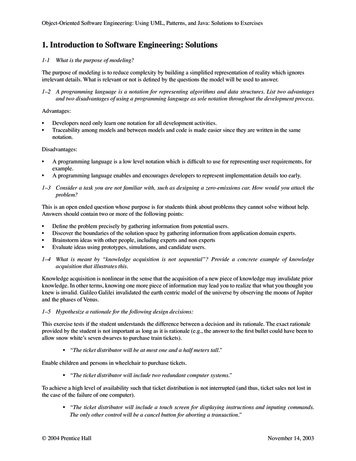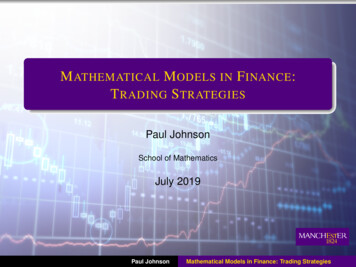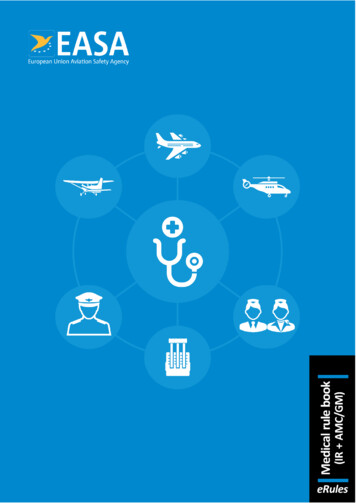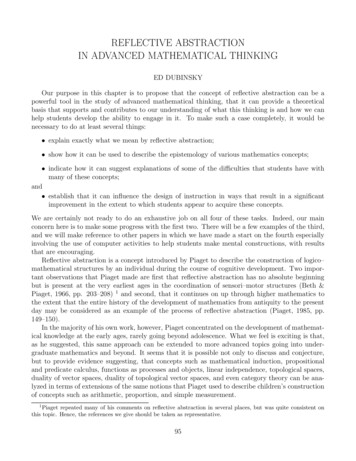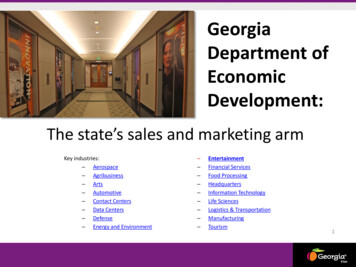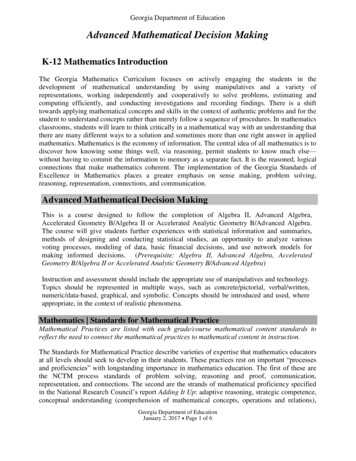
Transcription
Georgia Department of EducationAdvanced Mathematical Decision MakingK-12 Mathematics IntroductionThe Georgia Mathematics Curriculum focuses on actively engaging the students in thedevelopment of mathematical understanding by using manipulatives and a variety ofrepresentations, working independently and cooperatively to solve problems, estimating andcomputing efficiently, and conducting investigations and recording findings. There is a shifttowards applying mathematical concepts and skills in the context of authentic problems and for thestudent to understand concepts rather than merely follow a sequence of procedures. In mathematicsclassrooms, students will learn to think critically in a mathematical way with an understanding thatthere are many different ways to a solution and sometimes more than one right answer in appliedmathematics. Mathematics is the economy of information. The central idea of all mathematics is todiscover how knowing some things well, via reasoning, permit students to know much else—without having to commit the information to memory as a separate fact. It is the reasoned, logicalconnections that make mathematics coherent. The implementation of the Georgia Standards ofExcellence in Mathematics places a greater emphasis on sense making, problem solving,reasoning, representation, connections, and communication.Advanced Mathematical Decision MakingThis is a course designed to follow the completion of Algebra II, Advanced Algebra,Accelerated Geometry B/Algebra II or Accelerated Analytic Geometry B/Advanced Algebra.The course will give students further experiences with statistical information and summaries,methods of designing and conducting statistical studies, an opportunity to analyze variousvoting processes, modeling of data, basic financial decisions, and use network models formaking informed decisions. (Prerequisite: Algebra II, Advanced Algebra, AcceleratedGeometry B/Algebra II or Accelerated Analytic Geometry B/Advanced Algebra)Instruction and assessment should include the appropriate use of manipulatives and technology.Topics should be represented in multiple ways, such as concrete/pictorial, verbal/written,numeric/data-based, graphical, and symbolic. Concepts should be introduced and used, whereappropriate, in the context of realistic phenomena.Mathematics Standards for Mathematical PracticeMathematical Practices are listed with each grade/course mathematical content standards toreflect the need to connect the mathematical practices to mathematical content in instruction.The Standards for Mathematical Practice describe varieties of expertise that mathematics educatorsat all levels should seek to develop in their students. These practices rest on important “processesand proficiencies” with longstanding importance in mathematics education. The first of these arethe NCTM process standards of problem solving, reasoning and proof, communication,representation, and connections. The second are the strands of mathematical proficiency specifiedin the National Research Council’s report Adding It Up: adaptive reasoning, strategic competence,conceptual understanding (comprehension of mathematical concepts, operations and relations),Georgia Department of EducationJanuary 2, 2017 Page 1 of 6
Georgia Department of EducationAdvanced Mathematical Decision Makingprocedural fluency (skill in carrying out procedures flexibly, accurately, efficiently andappropriately), and productive disposition (habitual inclination to see mathematics as sensible,useful, and worthwhile, coupled with a belief in diligence and one’s own efficacy).1 Make sense of problems and persevere in solving them.High school students start to examine problems by explaining to themselves the meaning of aproblem and looking for entry points to its solution. They analyze givens, constraints,relationships, and goals. They make conjectures about the form and meaning of the solution andplan a solution pathway rather than simply jumping into a solution attempt. They consideranalogous problems, and try special cases and simpler forms of the original problem in order togain insight into its solution. They monitor and evaluate their progress and change course ifnecessary. Older students might, depending on the context of the problem, transform algebraicexpressions or change the viewing window on their graphing calculator to get the information theyneed. By high school, students can explain correspondences between equations, verbaldescriptions, tables, and graphs or draw diagrams of important features and relationships, graphdata, and search for regularity or trends. They check their answers to problems using differentmethods and continually ask themselves, “Does this make sense?” They can understand theapproaches of others to solving complex problems and identify correspondences between differentapproaches.2 Reason abstractly and quantitatively.High school students seek to make sense of quantities and their relationships in problem situations.They abstract a given situation and represent it symbolically, manipulate the representing symbols,and pause as needed during the manipulation process in order to probe into the referents for thesymbols involved. Students use quantitative reasoning to create coherent representations of theproblem at hand; consider the units involved; attend to the meaning of quantities, not just how tocompute them; and know and flexibly use different properties of operations and objects.3 Construct viable arguments and critique the reasoning of others.High school students understand and use stated assumptions, definitions, and previouslyestablished results in constructing arguments. They make conjectures and build a logicalprogression of statements to explore the truth of their conjectures. They are able to analyzesituations by breaking them into cases, and can recognize and use counterexamples. They justifytheir conclusions, communicate them to others, and respond to the arguments of others. Theyreason inductively about data, making plausible arguments that take into account the context fromwhich the data arose. High school students are also able to compare the effectiveness of twoplausible arguments, distinguish correct logic or reasoning from that which is flawed, and—if thereis a flaw in an argument—explain what it is. High school students learn to determine domains towhich an argument applies, listen or read the arguments of others, decide whether they makesense, and ask useful questions to clarify or improve the arguments.4 Model with mathematics.High school students can apply the mathematics they know to solve problems arising in everydaylife, society, and the workplace. By high school, a student might use geometry to solve a designproblem or use a function to describe how one quantity of interest depends on another. High schoolGeorgia Department of EducationJanuary 2, 2017 Page 2 of 6
Georgia Department of EducationAdvanced Mathematical Decision Makingstudents making assumptions and approximations to simplify a complicated situation, realizingthat these may need revision later. They are able to identify important quantities in a practicalsituation and map their relationships using such tools as diagrams, two-way tables, graphs,flowcharts and formulas. They can analyze those relationships mathematically to drawconclusions. They routinely interpret their mathematical results in the context of the situation andreflect on whether the results make sense, possibly improving the model if it has not served itspurpose.5 Use appropriate tools strategically.High school students consider the available tools when solving a mathematical problem. Thesetools might include pencil and paper, concrete models, a ruler, a protractor, a calculator, aspreadsheet, a computer algebra system, a statistical package, or dynamic geometry software. Highschool students should be sufficiently familiar with tools appropriate for their grade or course tomake sound decisions about when each of these tools might be helpful, recognizing both theinsight to be gained and their limitations. For example, high school students analyze graphs offunctions and solutions generated using a graphing calculator. They detect possible errors bystrategically using estimation and other mathematical knowledge. When making mathematicalmodels, they know that technology can enable them to visualize the results of varyingassumptions, explore consequences, and compare predictions with data. They are able to identifyrelevant external mathematical resources, such as digital content located on a website, and usethem to pose or solve problems. They are able to use technological tools to explore and deepentheir understanding of concepts.6 Attend to precision.High school students try to communicate precisely to others by using clear definitions indiscussion with others and in their own reasoning. They state the meaning of the symbols theychoose, specifying units of measure, and labeling axes to clarify the correspondence withquantities in a problem. They calculate accurately and efficiently, express numerical answers witha degree of precision appropriate for the problem context. By the time they reach high school theyhave learned to examine claims and make explicit use of definitions.7 Look for and make use of structure.By high school, students look closely to discern a pattern or structure. In the expression x2 9x 14, older students can see the 14 as 2 7 and the 9 as 2 7. They recognize the significance of anexisting line in a geometric figure and can use the strategy of drawing an auxiliary line for solvingproblems. They also can step back for an overview and shift perspective. They can see complicatedthings, such as some algebraic expressions, as single objects or as being composed of severalobjects. For example, they can see 5 – 3(x – y)2 as 5 minus a positive number times a square anduse that to realize that its value cannot be more than 5 for any real numbers x and y. High schoolstudents use these patterns to create equivalent expressions, factor and solve equations, andcompose functions, and transform figures.8 Look for and express regularity in repeated reasoning.High school students notice if calculations are repeated, and look both for general methods and forshortcuts. Noticing the regularity in the way terms cancel when expanding (x – 1)(x 1), (x –Georgia Department of EducationJanuary 2, 2017 Page 3 of 6
Georgia Department of EducationAdvanced Mathematical Decision Making1)(x2 x 1), and (x – 1) (x3 x2 x 1) might lead them to the general formula for the sum of ageometric series. As they work to solve a problem, derive formulas or make generalizations, highschool students maintain oversight of the process, while attending to the details. They continuallyevaluate the reasonableness of their intermediate results.Connecting the Standards for Mathematical Practice to the Standards for MathematicalContentThe Standards for Mathematical Practice describe ways in which developing student practitionersof the discipline of mathematics should engage with the subject matter as they grow inmathematical maturity and expertise throughout the elementary, middle and high school years.Designers of curricula, assessments, and professional development should all attend to the need toconnect the mathematical practices to mathematical content in mathematics instruction. TheStandards for Mathematical Content are a balanced combination of procedure and understanding.Expectations that begin with the word “understand” are often especially good opportunities toconnect the practices to the content. Students who do not have an understanding of a topic mayrely on procedures too heavily. Without a flexible base from which to work, they may be lesslikely to consider analogous problems, represent problems coherently, justify conclusions, applythe mathematics to practical situations, use technology mindfully to work with the mathematics,explain the mathematics accurately to other students, step back for an overview, or deviate from aknown procedure to find a shortcut. In short, a lack of understanding effectively prevents astudent from engaging in the mathematical practices.In this respect, those content standards that set an expectation of understanding are potential“points of intersection” between the Standards for Mathematical Content and the Standards forMathematical Practice. These points of intersection are intended to be weighted toward central andgenerative concepts in the school mathematics curriculum that most merit the time, resources,innovative energies, and focus necessary to qualitatively improve the curriculum, instruction,assessment, professional development, and student achievement in mathematics.Advanced Mathematical Decision Making Content StandardsNumber and OperationsStudents will extend their understanding and use of ratios, proportions to solve problemsinvolving in decision making.MAMDM.N.1 Students will extend the understanding of proportional reasoning, ratios, rates,and percents by applying them to various settings to include business, media, and consumerism.a. Use proportional reasoning to solve problems involving ratios.b. Understand and use averages, weighted averages, and indices.c. Solve problems involving large quantities that are not easily measured.d. Understand how identification numbers, such as UPCs, are created and verified.Georgia Department of EducationJanuary 2, 2017 Page 4 of 6
Georgia Department of EducationAdvanced Mathematical Decision MakingAlgebraStudents will explore the applications of functions, their characteristics and their use inmodeling. Vectors and matrices are employed for solving problems.MAMDM.A.1 Students will use vectors and matrices to organize and describe problemsituations.a. Represent situations and solve problems using vectors in areas such as transportation,computer graphics, and the physics of force and motion.b. Represent geometric transformations and solve problems using matrices in fields suchas computer animations.MAMDM.A.2 Students will use a variety of network models to organize data in quantitativesituations, make informed decisions, and solve problems.a. Solve problems represented by a vertex-edge graph, and find critical paths, Euler paths, andminimal spanning trees.b. Construct, analyze, and interpret flow charts to develop an algorithm to describeprocesses such as quality control procedures.c. Investigate the scheduling of projects using PERT.d. Consider problems that can be resolved by coloring graphs.MAMDM.A.3 Students will create and analyze mathematical models to make decisionsrelated to earning, investing, spending, and borrowing money.a. Use exponential functions to model change in a variety of financial situations.b. Determine, represent, and analyze mathematical models for income, expenditures, andvarious types of loans and investments.MAMDM.A.4 Students will analyze and evaluate the mathematics behind various methods ofvoting and selection.a. Evaluate various voting and selection processes to determine an appropriate method for agiven situation.b. Apply various ranking algorithms to determine an appropriate method for a givensituation.GeometryStudents apply tools to model geometric situations and solve problems. Students extendtheir knowledge of right triangle trigonometry.MAMDM.G.1 Students will create and use two- and three-dimensional representations ofauthentic situations.MAMDM.G.2 Students will solve geometric problems involving inaccessible distances usingbasic trigonometric principles, including the Law of Sines and the Law of Cosines.Georgia Department of EducationJanuary 2, 2017 Page 5 of 6
Georgia Department of EducationAdvanced Mathematical Decision MakingData Analysis and ProbabilityStudents will explore representations of data and models of data as tools in the decisionmaking.MAMDM.D.1 Students will determine probability and expected value to informeveryday decision making.a. Determine conditional probabilities and probabilities of compound events to makedecisions in problem situations.b. Use probabilities to make and justify decisions about risks in everyday life.c. Calculate expected value to analyze mathematical fairness, payoff, and risk.MAMDM.D.2. Students will build the skills and vocabulary necessary to analyze and critiquereported statistical information, summaries, and graphical displays.MAMDM.D.3 Students will apply statistical methods to design, conduct, and analyze statisticalstudies.MAMDM.D.4 Students will use functions to model problem situations in both discrete andcontinuous relationships.a. Determine whether a problem situation involving two quantities is best modeled by adiscrete (pattern identification, population growth, compound interest) or continuous(medication dosage, climate change, bone decay) relationship.b. Use linear, exponential, logistic, piecewise and sine functions to construct amodel.Terms/Symbols: Networks, weighted average, indices, vector, critical path, Euler path,minimal spanning trees, PERT, Law of Sines, Law of Cosines, payoff, risk, discrete,continuous, logistics, annuity, future value, present value, ranking, margin of error, cyclical,period, amplitude, phase shift, commission, salary, perpetuity, electoral college, periodicfunctions, statistical bias.Georgia Department of EducationJanuary 2, 2017 Page 6 of 6
Advanced Mathematical Decision Making This is a course designed to follow the completion of Algebra II, Advanced Algebra, Accelerated Geometry B/Algebra II or Accelerated Analytic Geometry B/Advanced Algebra. The course will give students furthe

